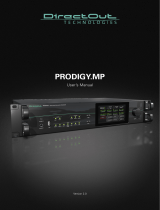Page is loading ...

4
Introduction
ThankyouforchoosingtheGrimmAudioCC1CentralClockdistributorforyour
productionenvironment.Thisproductfeaturesarichsetofdistributorfunctions,
baseduponanultralowjitterclockoscillator.Itembodiesourcompanyphilosophy
ofprovidingthemosttransparentsignalchainpossible,enablingyoutoachievethe
bestpossibleresultssonicallyandartistically.LargepartsoftheCC1circuitry,like
theoscillatoranditspowersupplies,useadiscretedesign.BecauseofthisaCC1
hasmorethan700components.Duringconstruction125seperateelementsare
tested.
TheCC1canbeusedinawidevarietyofapplicationssuchas:
•HouseSyncgenerationinaudioand/orvideostudios.Sixteenoutputspermitthe
useofthereliable“star”distributionscheme.TheextremelylowjitteroftheCC1
clockoutputsmaximisesthesoundqualitypotentialoftheattacheddevices.Incase
youneedtoslaveyoursystemtovideoclock,pleaseinsertaGrimmAudioVCC,
‘videotowordclockconverter’beforetheclockinput.
•Clockstabilityimprovement,andhenceimprovedsound,ofdigitallivedesksand
digitalsnakes.
•Clockdistributioninbroadcaststudios.
•Improvementofyourhomeaudiosystem.Forinstanceinconjunctionwithword
clockequipeddevicesorasreclockunitinbetweenatransportormediasystem
andaDAconverter.
Thismanualdescribeshowtosetuptheunitinyourstudio,liveorhomeenviron-
mentaswellasimportanttipsonhowtogetthebestperformancefromtheCC1.In
addition,somebackgroundinformationontheunit’soperationisprovided.
Wehopethisinvestmentwillbringyoumanyyearsofcreativeenjoymentandhelp
youachieveyourgoals.

5
Important Safety Instructions
Grimm Audio gaat er van uit dat u deze Engelstalige tekst volledig begrijpt. Als u hier moeite
mee heeft dient u contact op te nemen met Grimm Audio. Op verzoek sturen wij u een vertaling
toe.
Grimm Audio nimmt an, dass Sie diesen Englischen Text völlig verstehen. Wenn notwendig,
nehmen Sie bitte Kontakt auf mit Grimm Audio. Auf Wünsch wird Ihnen eine Übersetzung zu-
geschickt.
Grimm Audio suppose que le lecteur comprend parfaitement le texte en Anglais ci-dessous. En
cas de doute s.v.p. contacter Grimm Audio. Si necessaire, on pourra vous envoyer une traduc-
tion.
Grimm Audio da por supuesto que el texto en versión Inglesa no ofrece ninguna duda de in-
terpretación y se entiende integramente. Si este no fuese su caso rogamos contacte con Grimm
Audio quien, a petición, se encargaría de enviarle la correspondiente traducción.
Please follow these precautions when using this product:
1.Readtheseinstructions.
2.Keeptheseinstructions.
3.Heedallwarnings.
4.Followallinstructions.
5.Dangerousvoltageisinsidethisapparatus.Openingisonlyallowedbyqualified
servicepersonnel.
6.Verifylinevoltagebeforeuse.
7.Donotdefeatthesafetypurposeofthepolarizedorgrounding-typeplug.A
polarizedplughastwobladeswithonewiderthantheother.Agrounding-typeplug
hastwobladesandathirdgroundingprong.Thewidebladeorthethirdprongare
providedforyoursafety.Whentheprovidedplugdoesnotfitintoyouroutlet,con-
sultanelectricianforreplacementoftheobsoleteoutlet.
8.Protectthepowercordfrombeingwalkedonorpinched,particularlyatplugs,
conveniencereceptables,andthepointwheretheyexitfromtheapparatus.
9.Unplugthisapparatusduringlightningstormsorwhenunusedforlongperiods
oftime.

6
10.Donotusethisapparatusnearwater.
11.Donotusethisapparatusoutside.
12.Donotexposetheapparatustodrippingorsplashing.Donotplaceobjects
filledwithliquids(flowervases,drinkcans,coffeecups,etc)ontheapparatus.
13.Cleanonlywithadry,soft,non-fluffycloth.Donotsprayanyliquidcleaneronto
thecabinet,asthismayleadtodangerousshocks.Donotsprayanyliquidcleaner
ontothefaceplate,asthismaydamagethefrontpanel.
14.Installinaccordancewiththemanufacturer’sinstructions.
15.Donotinstallnearanyheatsourcessuchasradiators,heatregisters,stoves,or
otherapparatus(includingamplifiers)thatproduceheat.Avoidexposuretodirect
sunlight.
16.Useonlyattachmentsoraccessoriesspecifiedbythemanufacturer.
17.Useonlywithacart,stand,bracket,ortabledesignedforusewithprofessional
audioormusicequipment.Inanyinstallation,makesurethatinjuryordamagewill
notresultfromcablespullingontheapparatusanditsmounting.Ifacartisused,
useprecautionwhenmovingthecart/apparatuscombinationtoavoidinjuryfrom
tip-over.
18.Thisunitrunsslightlywarmwhenoperatednormally.Operateinanormalventi-
latedarea.Ifthisproductwillbeinstalledinarack,makecertainthereissufficient
airmovementwithintherack.
19.Referallservicingtoqualifiedservicepersonnel.Servicingisrequiredwhenthe
apparatushasbeendamagedinanyway,suchaswhenthepower-supplycordor
plugisdamaged,liquidhasbeenspilledorobjectshavefallenintotheapparatus,
theapparatushasbeenexposedtorainormoisture,doesnotoperatenormally,or
hasbeendropped.
20.WARNING: Toreducetheriskoffireorelectricshock,donotexposethisappa-
ratustorainormoisture.

7
1. Installing
Unpacking and Inspection
YourCC1wascarefullypackedatthefactoryandthecartonitcameinwasde-
signedtoprotectitfromthetrialsandtribulationsofshipping.Keeptheboxandall
packingmaterials,sothatintheunlikelyeventthatyouneedtoreturntheCC1for
servicing,youcandososafely.
Mounting the CC1
TheCC1canmountinanystandard19”rack.TheCC1doesnotproduceRFfields
norissusceptibletothem.Youcanpositionitnearotherdigitalgearsuchascom-
puteranddiskrecorderswithoutworry.Ingeneralitisagoodideatokeepsome
distancebetweenmonitors(LCDandCRT)andaudioandwordclockcablesbecause
ofriskofinducedlowlevelnoiseduetostraymagneticfields.
GrimmAudioproductshavearealwoodfaceplatethatprovidesabeautifuland
vividappearance.Tomaintaintheoutstandinglooks,oneisadvisedtotakesome
precautions:
-DonotplacetheCC1inhumidnorverydryenvironments.Thewoodmightcrack.
-Donotusechemicaloralcoholbasedcleaneronthewood.
AC Power Hookup
TheCC1hasalinearpowersupplythatneedstobefactorysetforyourlocalline
voltage.MakesuretocheckthenotedlinevoltageonthebackbelowtheIECcable
entrance(‘wiredfor...V’)andverifythatthiscomplieswithyourlocallysupplied
linevoltage.GrimmAudiocannotberesponsibleforproblemscausedbyusing
theCC1withimproperACwiringorvoltage.SincetheCC1doesnothaveapower
switchonthefrontpanel,aconvenientwaytopowerdowntheunitistousea
powerstripequippedwithaswitch.

8
2. Signal Connections
TogglesMaster44.1/48kHzandSlave
Togglesgroup1sampleratemultiplicationfactor
Togglesgroup2sampleratemultiplicationfactor
AES3-out
(follows
AES3-in when
available
and selected,
otherwise
group 2)
AES-in
lockstatus
Inputs
(AES3-in also
for reclocking
purpose)
AES-out
behavior
(thru or
mute) Impedance
group1
(75 Ohm
or Lo-Z)
Impedance
group2
(75 Ohm
or Lo-Z)
Phaseof
BNC11,
12,13,14
(normal or
180°)
Outputs
group1
Outputs
group2 Indication
offactory
setline
voltage
value
unlock
behavior
(hold or
mute)
3. Operation
Master mode
Theleftmostfrontpanelpushbuttonselectsbetweentwobaseclockrates:44.1kHz
or48kHz.Thetwootherpushbuttonsdeterminetheactualclockfrequencytrans-
mittedacrossthe16BNCoutputs.Theycontrolintwogroups.Group1arechan-
nels1-12.Thesecondpushbuttonsetsthemultiplicationfactorforthisgroupto
1x,2xor4x.Group2arechannels13-16,andtheirmultiplicationfactorissetby
thethirdpushbutton.Setting“48kHz”usingtheleftmostpushbutton,“1x”onthe
middleselectorand“2x”ontherightmostselectorwillsettheclockrateongroup1
BNC’sto48kHzandongroup2BNC’sto96kHz.

9
TheAES3outputhastwofunctions,dependingonthesettingofthedipswitch
marked“aes”ontherear.Itdetermineswhethertheaudiocontentfoundatthe
AES3inputispassedthroughtotheoutput(“thru”)ornot(“mute”).In“mute”mode
theAES3datawillbeblackandrunattherateselectedforgroup2.In“thru”mode,
theAES3outputwillobviouslyrunatthesamerateastheAES3input.Onlossof
inputsignal,theoutputwillremainatthesamesamplingrate.
TheexactbehaviouroftheAES3outputinmastermodedependsontheusecase:
1.NosignalconnectedtotheAES3input.TheAES3outputisablacksignal(no
audio)withthesamesamplingrateastheGroup2BNCoutputs.Thechannelstatus
bitsindicate“Grade1reference”iftheCC1hasgonethroughtheoptionalfrequen-
cycalibration,otherwise“Grade2reference”.TheAESlockindicatorontherearis
off.
2.AsignalisappliedtotheAES3inputthatisnotsynchronoustotheCC1.The
AES3outputisablacksignalwiththesamesamplingrateastheGroup2BNCout-
puts.TheAESlockindicatorontherearblinks.
3.AsignalisappliedtotheAES3inputthatissynchronoustotheCC1,butthe“aes”
dipswitchissetto“mute”.TheAES3outputwillstillbeblackandsynchronous.The
presenceoftheaessignalhasnoeffect.In“master”modewiththe“aes”dipswitch
setto“mute”,anysignalattheAES3inputisbasicallyignored,exceptthatthe“aes
lock”lightontherearwillbeontoindicatethepresenceofasynchronousinput.
4.AsignalisappliedtotheAES3inputthatissynchronoustotheCC1,andthe
“aes”dipswitchissetto“thru”.TheAES3outputfullycopiesaudioandsubcode
data(butnotthejitter!)fromtheAES3input.InthismodetheAES3outputwill
neverindicate“grade1”asAES11requiresablacksignal.The“aeslock”lightison.
5.Iftheinputsignalislostfromcase4,thesamplingfrequencysettingisretained,
assuddenlossofsignalismostlikelyaccidental.Thisisdifferentfromcase1
whereanAES3inputsignalwasneverpresent.IftheremovaloftheAES3inputwas
onpurpose,changingthegroup2multipleonthefrontwillreturntocase1,and
theAES3outputwillonceagainbesynchronoustotheselectedmultipleofgroup2.
Slave mode
Slavemodeisthethirdsettingontheleftmostselector.Inslavemode,theCC1will
lookatthewordsyncinputaswellastheAES3inputforavalidsignal.Slavemode
permitsthefollowingusecases:
1.Wordsynconly.Uponselectionofslavemode,theCC1selectsthewordsync
input.Themiddleandrightselectoronceagainsetgroups1and2toamultipleof
thebaserate.TheAES3outputwillbeblack,synchronisedtogroup2andthechan-

10
nelstatusmarked“noreference”.Uponlossoflock,theoutputfrequencywillbe
heldconstant,seecase4.
2.AES3only.Uponselectionofslavemode,theCC1selectstheAES3input.The
“aes”dipswitchattherearselectswhethertheaudiodataistransmitted(thru)or
not(mute).Inthrumode,theAES3outputwillobviouslyrunatthesamemultipleas
theAES3input.Inmutemodeitwillbesynchronoustogroup2,audioisblackand
marked“noreference”.Uponlossoflocktheoutputratewillbeheldconstant,see
case4.The“AESlock”lightontherearwillbeonaslongastheCC1PLLislocked.
3.BothAES3andwordsyncarepresent.Wordsyncwilltakeprecedenceoverthe
AES3input.In“thru”modetheAES3outputwillproduceajitter-freecopyofthe
AES3input,providedtheinputsignalissynchronous.In“mute”modetheAES3
inputwillbeignoredaltogether.UponlossoftheAES3inputtheAES3outputwill
reverttoblack.Uponlossofthewordsyncinputtheoutputfrequencywillbeheld
constant(within1ppmofthelastdetectedfrequency)andthefrontslavelightwill
blinktoindicateanerror.Thefaultconditionisclearedeitherbyreattachingthe
wordsyncorbycyclingthesourceselectorthroughthetwomastermodesbackto
slavemodetoforcetheCC1tolocktotheAES3signalinstead.TheCC1willnever
automaticallyswitchfromwordsynctoAES3topreventclockloops.
4.NovalidsignaloneitherwordsyncorAES3input.Theresponseisnowdeter-
minedbythedipswitchnamed“unlock”.Whensetto“thru”,theclockfrequencywill
beheldconstantwithin1ppmofthelastvalidmeasuredfrequency.Whensetto
“mute”,theoutputswillbemuted.Inbothcasestheslavelightwillblinktoindicate
anerror.The“mute”modeisadvantageousatforinstancepostproductionwhere
theclockusuallyisoutofsightinamachineroom.Uponlossoflock,allclocksdis-
appearandyoursoftwareautomaticallyprovidesawarning.The“thru”modehasan
advantageinforinstanceliverecordingorPublicAddress.Heresoundshouldnever
mute,whateverhappens.
Lock indication
TheCC1detectswhethertheinputsignalisamultipleof44.1kHzor48kHz,and
indicatesthisontheLEDsabovethesourcepushbutton.Thefrequencymultiple
settingsofgroups1and2remainassetbytheuser.WhiletheCC1acquireslock,
theslavelightwillblink.Thiscantakeupto20s,onaccountoftheCC1’sextremely
slowPLLdesign(seechapter6,“JitterandPLL’sexplained”).Oncefrequencylock
isachieved,theslaveLEDwillcomeoncontinuously.ThePLLwillthensettleto0º
phaselockwiththeinputinanevenslowermode.Thesmallestachievablephase
errordependsmostlyonthestabilityoftheincomingclock.Thestatic(average)
phaseerrorisfactory-alignedtowithin50ns.

11
The“lock”LEDontherearindicatestheAES3receiverstatus:
1.Off:NoAES3signalpresent.
2.On:AES3signalpresentandfoundtobesynchronouswiththeCC1.
3.Blinking:AnAES3signalispresentbutitisoutofsyncwiththeCC1.
Impedance
The“impedance”DIPswitchesontherearalloweachindividualoutputtobeset
tolow-impedance(25ohmstypical)orcharacteristic(75ohms)impedance.The
switchesarefactorysetto75ohms.Shouldthereceivingdevicehaveproblems
recognisingthewordsyncsignal,youmighttrythelowimpedancesetting.
Wordsyncconnectionsareusually5Vsquarewavestransmittedover75ohm(vid-
eo)coaxcables.Althoughthewordclockfrequencyitselfisrelativelylow,thetran-
sitionsaresteep.Takenasawhole,wordsyncisawidebandsignal,necessitating
characteristicterminationatleastatoneendofthecable.Single-terminatedlines
areusuallyterminatedonthesourceend.Betterstillisseriesterminationonthe
transmitendandparallelterminationonthereceivingend.Thisminimisesreflec-
tionsevenwhenthecableimpedanceisnotexact.Doubleterminationlikethispro-
ducesa6dBloss,resultingina2.5Vsignal.AllGrimmAudioproductsaredesigned
toworkinthismanner.
Thereisnostandarddefiningwordsyncconnections.Asaresult,impementations
varyacrossmakes.Outputsmaybeseriesterminatedorlowimpedance,DCorAC
coupled.Inputsmaybeparallelterminatedorhighimpedance.Thisyields8permu-
tations,allofthemencounteredinthewild.TheCC1inputwillcorrectlyinterpret
allvariantswithoutusermanipulation,buttheimpedanceoftheCC1’soutputs
mayneedtobesetlowinsomecases.Aparallel-terminatedinputexpectinga4V
inputsignalwillonlyworkwiththeCC1’soutputimpedancesetlow.Afairnumber
ofproductswerefoundtohaveparallelterminatedinputbutstopworkingaround
2.5VwhichiswhytheCC1putsoutaslightlyhigher-than-normalvoltageinorderto
allowcorrectoperationinthefactorypresetmode.Nevertheless,someequipment
willonlyrespondcorrectlywhentheoutputimpedanceDIPswitchissettolow.
Phase
Channels11to14canbepolarity-reversed(180ºphaseshift)tocaterforequip-
mentthatusesthefallingedgetosynchroniseoninsteadoftherisingedge.Should
youencounteroperationalproblemswithequipment,eventhoughitislocked,
checkthemanualforanymentionofclockphaseandtrythe180ºswitchsetting.

12
AES and unlock switches
The‘aes’and‘unlock’switchescanbesetto‘‘mute’or‘thru’.Thebehaviorofthe
CC1inthesemodesisdescribedinChapters‘Mastermode’and‘Slavemode’.
Key Lock mode
IfyourCC1isusedinonesettingmostofthetimeyoucanuse“KeyLock”modeto
preventclockingerrorsbyaccidentalpressingofcontrolbuttonsontheCC1’sfront
panel.InthismodetheCC1doesnotrespondtothepushofanybutton.“KeyLock”
modeisengagedbyholdingthe“44.1/48/Slave”buttonduringpowerup.Itwill
thenlockthemodethatwassetbeforethelastpowerdown.Toleave“KeyLock”
mode,holdthe“44.1/48/Slave”buttonduringpowerupagain.
4. Setting up the Studio
Inadigitalstudioallequipmentwillneedtobesynchronised.Ifallthereisaretwo
boxes,onesendingandonetransmitting,allthatisneededisadigitalsignaland
therecipientwilllocktothat.Whenmultiplesourcesarefeedingintoonerecipi-
ent(e.g.adigitaldeskconnectedtoseveraldigitalrecordersandconverters),all
sourceswillneedtobesynchronous.Thisiswhatahousesync(akamasterclock)is
for.Severalformatsareinuse.TheAESpromotesastandardcalledAES11thatuses
anAES3link,butmostequipmenttendstouseawordsyncsignalonaBNCconnec-
tor.TheAES11standardistobeamendedtoincludethispractice.Wethinkthisisa
goodmove,sincethepurityofaclockrecoveredfromanAES3linkisrathersuscep-
tibletoissueslikecablelengthandbandwidthlimitations.TheAES3outputonthe
CC1isprovidedtocaterforthefewequipmentthatneedsAES11overAES3.When
theoutputisnotusedforthispurpose,itdoublesasajitterremovalfunctionfor
anyAES3signal(provideditissynchronouswiththeCC1).
Moststudiosthathaveintroducedahousesynchavenoticedachangeintheoverall
soundqualityoftheirequipment.Usuallyforthebetter,sometimesfortheworse.
Atissueisjitter(akintowowandflutter,butthenappliedtothesamplingclock).
Chapter6“Jitterexplained”willgointomoredetails.Theimportantpointtoremem-
beristhatjitteraffectsaudioqualityonlyatpointsinthechainwhereanactual
time-basedconversionistakingplace,typicallyADandDAconvertersbutalso
increasinglyasynchronoussamplingrateconverters.

13
Connection
TheCC1willusuallybelocatedinthemachineroom.Eachdeviceconnectedtothe
CC1issetto“slavetowordsync”.Thebestconnectionschemeis“stardistribu-
tion”witheachoutputoftheCC1connectedtoonedevice.Thesixteenoutputswill
normallysuffice.Daisychainconnectionsarebestavoided,asareT-junctioncon-
nections.Thelatterwillmostlikelyfailanywaybecauseofthelackofstandardisa-
tionofterminationimpedanceandsignallevel,nottomentionmechanicalfailureof
T-junctionsthemselves.
Trytopreventcirculatinggroundcurrentsthroughthecoaxcables(groundloops).
Ascoaxcablesgo,theyareunbalancedandcurrentsflowingthroughthecable
shieldswillimposeanerrorvoltageonthesignal,causingjitteratthereceivingend
thatwasn’tthereatthetransmittingend.Onecommoncauseofcirculatingcurrents
isleakagecurrentthroughthepowersupplyofanungroundedproduct.Anotheris
voltagedropbetweentheearthgroundconnectionbetweendevicesthatarelo-
catedfarapart.Minimizingtheloopareaencircledbytheentireloop,comprising
thewordsynccableandthemainscordsisusuallyagoodidea.Byallmeans,never
defeatthesafetyearthconnectionofanydevicethatisdesignedtohaveanearth
connection.Liftinggroundsmayproducealethalshockhazard.
TheCC1itselfhasalow-impedancereferenceplaneattherear,insuringthatit
willneverbeaffectedbycirculatingcurrents.Notallequipmentisdesignedinthis
manner.Incaseyoursystemholdsinterfacingequipmentthatissensitivetoground
loops,GrimmAudiohasanisolationtransformeravailableondemand(CI1).Such
devicesdegradeclockqualitysomewhatsotheyshouldbeavoidedwhendriv-
ingequipmentofwhichtheAD/DAsectionisused.Whenacurrentloopinvolving
severalpiecesofgearneedstobebroken,itisbesttoinstalltheCI1inlinesfeed-
ingnon-performance-criticalequipmentsuchasdigitalI/Osoundcards,andtouse
normal,directconnectionsbetweentheCC1andanyAD/DAconvertingequipment.
AES3 reclocking
Apartfromthewordsyncinputandsixteenoutputs,theCC1alsosportsanAES3
inputandoutput.TheoutputcancarryanAES11DARSsignalbutitmayalsobe
usedtotransmitare-clocked(de-jittered)copyofthesignalattheAES3input.This
maybeusefulwhendrivingajittersensitivedevicelackingawordsyncinput,most
typicallyanoutboardDACinthemonitoringsystemoradigitalloudspeaker.
Thereclockingfunctionisavailableinallconfigurations,thatis,master,slavedto
wordsyncorslavedtotheAES3inputitself.Apartfromthelattertrivialcasethis
impliesthatthesourceoftheAES3signalshoulditselfbesomehowsynchronised
totheCC1.Settingthe“aes”switchto“thru”activatesthereclockingmode,pass-
ingmaximallyjitter-freesignaltoe.g.aDAC.Inmostcasesthiswillimprovereplay
qualitysignificantly.

14
Inconsumeruse,mostequipmentfeaturesRCAS/PDIFconnectorsinsteadofXLR
AES3connectors.TofacilitateHi-FiuseoftheCC1,allourconsumerunitsare
shippedwithanS/PDIF<->AES3conversioncableset.
Clock Loop
Aclockloopisarunawaysituationwheretwodevicesareslavedtoeachother,for
instancetheCC1slavedtoarecorderwhichinturnisslavedtotheCC1.Neitherde-
viceistheclockmasterandtheresultwillusuallybethattheclockfrequencyends
upatanextremeofthetuningrangeofoneofthedevices.BeforesettingtheCC1
toslave,insurethattheclockinputoriginatesfromamaster.
PLL setting in attached devices.
Audiodevicescapableoflockingtoanexternalclockuseaphase-lockedlooptodo
so.Detailsofthisarecoveredinourwhitepaper“PLLandclockbasics”thatcanbe
foundontheinfopageofourwebsite.AnimportantthingtoknowforaCC1useris
thatsomeproductshavetwomodes,usuallycalled“fast/wide”or“slow”.Theslow
settinghasthebestsuppressionofincomingjitter,andistheoptimumchoicewhen
theincomingclockispolluted.Thedownsideoftheslowsettingisthatthejitterin
therecoveredclockisfullydominatedbytheclockoscillatorthatformspartofits
PLL.Iftheincomingclockhappenstobemuchstablerthanthat,theslowmodewill
actuallyendupaddingjitter.Thelatterscenarioisalmostguaranteedtobethecase
withtheCC1,whichissignificantlycleanerthananyclockoscillatorwe’vefound
incommerciallyavailableaudioproductssofar.Asarule,inthiscaseitisusually
bettertoselectthe“fast”mode.Infastmode,thePLLwilltracktheincomingclock
morecloselyandiftheincomingclockisextremelyclean,thesamewillgoforthe
regeneratedclock.
ProductsthathaveafixedslowPLL,suchasthosefromApogee,dCS,LynxorPrism
Sound,willimprovecomparablylittlecomparedtoproductswithaswitchableor
relativelyfastPLLlikethosefromAvid,LavryEngineering,MOTU,Mytec,SSLor
RME.Digitalloudspeakersthatfeatureawordclockinput,likeDynaudioAir,will
alsobenefitfromslavingtotheCC1.
Syncing to Video
Beforecomplicateddigitalstudiosbecamepractical,videostudioshavebeenus-
inghousesyncsfordecades.Assoonasmorethanonecameraisused,allsources
needtobesynchronised.Apartfromatimebasereferencethereisalsoaneed
toknowtheactualtimingofaframe.Thisinformationisprovidedbytimecodes.
Althoughthetimecodesignalisofcoursesynchronouswiththevideosync,itis
usuallytransmittedseparately.Insomecasesthe“LTC”codeisusedasmainvideo

15
sync,butfortunatelyitisgoingoutoffashion.LTCisprobablytheleaststabletime
referencearound.
Enterdigitalaudio.Theaudiotracknowneedstobesynchronisedtothepicture.
Wordsynchasabettertimeresolutionthanvideosync,butstillthemostcommon
practiceislockingtheaudioclocktothevideoclock.Evenmoderndigitalvideopro-
ductionpracticetendstolockaudiotoananaloguevideosignal.Thisisunfortunate
becauselowjitterisnotexactlyadesignspecforavideosyncgenerator.
TheCC1cannotslavetovideosyncdirectly.Inordertoavoiddirectcrosstalkbe-
tweentheblack-burstgeneratororreceiverandtheaudioclock,wehaveomitted
videosyncfunctionality.OurbestadviseistousetheCC1astheaudiomaster
andslaveallvideototheaudiowordsync.Ifyouneverthelessdoneedtoslavethe
audiosystemtovideosyncyoucaneitherbuyourVCC‘VideotoWordClock’con-
verteroruseanyothergenericvideotowordclockconverter.Connecttheretreived
wordclocktotheCC1’swordclockinputandhavetheCC1cleanupthesyncand
distributeclocktotheaudiodevicesasusual.Theextraordinarystabilityofthe
CC1’sPLLwillmakesuretheresultcomesascloseaspossibletomakingtheaudio
chainmaster.
Hints
•Selectdecentquality75Ohmcoaxcablesandcertainlydonotskimponthequal-
ityoftheconnectors.
•Makecablesnolongerthannecessary.
•Cablesaddpropagationdelay.Itisexceedinglyrarefordifferencesinclockphase
toaffecttheinteroperabilityofconnectedaudioequipment,butifithappens,using
equallengthcablesthroughouthelps.
•Disconnectunusedgear.
•IdeallydonotleavethewordclockinputconnectedwhentheCC1ismaster.
Althoughunlikely(theCC1hasarelaytoactivelydisconnecttheinputwhennotin
use),thereisapossibilityofcross-talkfromtheinputclocktotheoutputs.Like-
wise,donotleaveanAES3cableattachedifnotneeded.

16
5. Pro Tools
AvidProToolsisbyfarthemostcommonDAW,warrantingaspecialsectionon
howtosetuptheCC1inaPTrig.Inourexperiencedescribedmethodistheset-up
thatleadstothebestsoundquality.Anydeviationfromthismethodmightgiveyou
stablesync,butwillprobablynotbesonicallyoptimal.
Pro Tools in music production, CC1 master
ProTools192interfacesfeaturea“LoopSync”functionwhereclockcablesarecon-
nectedinaring:every“LoopSyncin”isconnectedtothenextunit’s“LoopSync
out”,thelastunitconnectstothefirst.Likeinanycorrectclocksetup,oneunitis
masterandallothersslave.TheadvantageofLoopSyncisanyunitcanbedesig-
natedmasterandrunonitsinternalclock.Allothersslavetothatunit.TheLoop
Syncinputofthemasterunitisignoredandeffectivelyanordinarywordclockdaisy
chainresults.NowifProToolsistoslavetowordclock,theunitthatreceivesthe
wordclockalwaysbecomesloopmaster,theothersautomaticallyslavetoLoop
Sync.WecanmakeuseofthisfeaturebyfoolingthesystemintobelievethatLoop
Syncisinuse,whileactuallyastarclockdistributionisutilized.Starclockdistribu-
tionhastheadvantagethatitismorefailsafethandaisychainingandjittergainof
subsequentPLL’sisavoided.
•ConnectanoutputofCC1’sgroup2tothe“ExternalWordClock”inputofthefirst
unitinthechain(ifpresenttheSyncI/O,otherwisethefirst192).
•ConnecttheoutputsofCC1’sgroup1totheLoopSyncinputofeach“192”inter-
face.Every192getsitsownconnectiontotheCC1(stardistribution).Makesure
group1issetto‘x1’.
Incaseyouneedtorunhighersampleratesthan44.1or48kHz,onlysetgroup2
ontheCC1frontpanelto“x2”or“x4”andleavegroup1on“x1”.ThisbecausePro
Tools“ExternalWordClock”inputneedstoreceivetheactualsamplerate,butthe
LoopSyncinputsalwaysrunatthebaserate.
•Softwaresettings:
Setup – session setup
1.SetSyncsourceto“WordClock”.Thisconfiguresthefirstunittolocktoex-
ternalwordclockandtheotherstoloopsync(indicatorslightup).
Pro Tools in music production, CC1 slave
AnalternativesetupwhenusingaSyncI/Oasfirstunitinthechainistoassignthe
SyncI/OmasterandslavetheCC1toitsLoopSyncoutput.Theadvantageisthat

17
thewholesystemwillautomaticallytracktheproject’ssamplerate.Disadvantage
isthatintheoryjitterontheCC1’soutputswillbeslightlyhigher.TheCC1’sjitter
attenuationhoweverissolargewedonotexpectthistobeaproblem.
•ConnecttheLoopSyncoutputoftheSyncI/O(whichisfirstunitinthechain)to
thewordclockinputoftheCC1.PutCC1inslavemode.
•ConnecttheoutputsofCC1’sgroup1and/orgroup2totheLoopSyncinputof
each“192”interface.Every192getsitsownconnectiontotheCC1(stardistribu-
tion).Makesuregroup1and2aresetto‘x1’.
•Softwaresettings:
Setup – session setup
1.SetSyncsourceoftheSyncI/Oto“Master”.All192interfacewillautomati-
callyswitchtoLoopSync,whichistakencareofbytheCC1.
Pro Tools in post pro.
Hereyou’llneedtosynctovideoandtimecode.Asoutlinedabove,setthevideo
equipmenttolocktowordsyncoruseavideosyncgeneratorthatacceptsaword
syncinputfromtheCC1.NaturallytheProToolshardwareisreceivingwordclock
directlyfromtheCC1.AlsoconnectvideosynctotheSyncHD,itwillbeusedjust
fortimecodesynchronisation.
Thewordclockconnectionsareasdescribedintheformerparagraphs“ProTools
inmusicproduction”.Specialattentionisneededforthetimecodeconnection.Up
tillProTools8therewasnowayofcombiningtheSonyP2“MachineControl”time
codesignalwithanexternalwordsyncliketheCC1.SelectingSonyP2forcedthe
SyncI/Otoslavetovideosync.WithcurrentversionsofProToolsyoucanlock
towordclockwhileatthesametimeusingthevideorefinputontheSyncHDfor
frameedgealignmentofP2sync.However,thisonlyworksforPALandNTSC,not
forhidefrates.Itishopedthatafuturesoftwareupdatewilladdressthis.Inthe
meantime,forhidefproduction,pleaseusethefollowingworkaround.
SincethereisnosuchissuewithLTC,wegettousethreeconnectionstotheSync
HD:wordclock,LTCandSonyP2forpuremachinecontrol.Forclocking,havePro-
Toolsslavetowordclockasdescribedinthismanual.Inthiscasedonotconnect
videosynctotheSyncHD.Thisinsuresthat,ifyouhappentoaccidentallyswitchto
thevideosyncinput,yougetaclearerrormessagetoalertyoutotheproblem.For
timecodeandmachinecontrol,followthenextsteps:
•Softwaresettings(takecaretoexecutethefollowingstepsintheorderde-
scribed):

18
Setup – Peripherals
1.Onthe“Synchronisation”tab:selectdevice“SyncHD”andport“any”(theLTC
inputwillbeautomaticallyselected)
2.Onthe“MachineControl”tab:tick“9pinsserial”(SonyP2).Untick“useserial
timecodeforpositionalreference”.LeavingthisoptiontickedcausestheSync
HDtotrysyncingtovideosyncinsteadofwordsync.Anadditionaldisadvan-
tageofSonyP2isthatitdoesnotsporta“continuousresync”likeLTC,signal-
ingtimecodeonlytogetherwithtransportcommands.
Setup – Session setup
3.SetSyncSourceto“WordClock”(thepreviousstepwillhaveautomatically
selectedvideosyncinstead,hencetheneedforexecutingthestepsinorder).
TheLoopSyncindicatorswilllightup.
Controllingtheexternalmachinecanbedoneintwoways:
a.ThetransportbuttonsonProToolscontrolthemachineviatheSonyP2interface.
ThemachinegeneratesLTC.ProToolsisslavedthroughtheSyncI/O’sLTCinput
oranyotherLTCtoMTCconverterconnectedtoyourcomputer.Lockisachieved
withinonesecond.Thisisthepreferredmethod.
b.ProToolsiscontrolleddirectlybyitstransportbuttons.Theexternalmachine
locatesandgetsintoplaythroughSonyP2locatorcommands.Theuserselectsa
cuepointandhitsplay.Theexternalmachinewillrewindtothistimecodeminusa
pre-rollandstartsrolling.ProToolswaitsuntilitseesthecorrecttimecodecoming
back(ProToolsslavestotheLTCofthemachine).Apotentialproblemoccurswhen
theexternalmachinefailstoachievesyncduringthepre-rollperiod.Whenevery-
thingisslavedtowordsyncthereislittlechanceofsuchathinghappeningandone
secondofpre-rollshouldsuffice.Whileplaying,ProToolswillrunintriggersync
mode.Thatis,onceit’sstartedplayingitwillignorepositionalinformation,verify-
ingonlythattimecodeisstillrunning.Thismethodmayforinstancebeselected
whenusingharddiskvideoplayers.
6. Jitter and PLL’s explained
Jitterisaninstabilityinthetimingofaclocksignal.Ideallytherisingorfalling
edgesofaclocksignalareallseparatedbyexactlythesameamountoftime.In
reality,thetimingismoreuncertain.Thegraphbelowshowsthetime-domainview
oftheproblem.

19
Astableandajitteryclocksignal
Wecanalsolookattheproblemspectrally.Anidealclockhasonlyasinglefrequen-
cycomponents(andharmonics).Allenergyisconcentratedonaninfinitelynarrow
frequencyband,seethetoppicturebelow.Whenjitterispresent,sidebandsoccur.
Somespectralenergyislocatedawayfromtheclock.Thefasterthetimingchatters,
thefurtherawayfromthemainfrequencyyou’llfindenergy.
frequency
frequency
Amplitude Amplitude
Jittery clock
Jitter-free clock,
slightly off the
ideal frequency
Theredcurveinthebottomgraphshowsonlyrandomjitter.Sometimesjitter
isperiodicalandthenyouwouldn’tseeasmoothslopebutsharppeaks.Anim-
portantnoteisthatfrequencyaccuracyhasabsolutelynothingtodowithjitter
atall.Theredgraphshowsajitteryclockwithanexactlycorrectfrequency,say
44100.0000000Hz,theblueoneshowsaclockthat’ssomewhatoffbutotherwise
brilliantlystable.Afrequencyerrorcanbeannoyingfromapracticalperspective,
Spectraofclocksignals

20
butasfarassignalqualityisconcernedyou’rebetteroffwithastableclockatan
inexactfrequency.
Jitterisnotaprobleminfullydigitalprocesses.Aslongasitisn’tsolargethata
processorcan’tdistinguishthepreviousbitfromthenext,all-digitalprocessesare
completelyindifferentaboutjitter.Theproblemoccurswhenyougofromtheana-
loguedomainintothedigitaldomainorback.Digitalaudiopresumesuniformsam-
pling.Thatway,givenastringofnumbersandknowledgeofthesamplinginterval,
youcanperfectlyreconstructasampledsignal.Withjitterthattheoryfallsflatonits
back.
Imaginethesignalontop.TheADconvertersamplesitatneatlyuniformintervals.
TheDAconverterreconstructsthecorrectvaluesbutitgetsthetimingwrong.The
differencebetweentheredandbluecurveshowstheerror.Ortaketheconverse:
theDACisfinebuttheADCtooksamplesatthewrongtime.Theeffectismuchthe
same.What’sworseinthiscaseisthatthenumberswe’verecordedarenowwrong.
InthepreviouscasewecouldslapinabetterDAC,withajitteryADCthegameis
over.
PLL’s
Converterchipsneedahighfrequencyclocksignal,usuallysomethingaround
22MHz.Itisalwaysmadebyalocaloscillator(anythingfromasimpleRCoscillator
inareceiverchiptoacrystaloscillator)regardlessofwhethertheunitisoperating
inmasterorslavemode.Thislocaloscillatorisindispensible:externalsyncsig-
nalsmaybeAES/EBU,asampleratefrequency“wordclock”orevenavideosignal,
neitherofwhichareofanydirectusetotheAD/DA.Instead,thelocaloscillatoris
speduporsloweddowntomakeitruninstepwith(“lockedto”)thesyncsignal.A
systemthatusesalocaloscillator“pulled”insyncwithanexternalsignaliscalled
aPhaseLockedLoop(PLL).A“phasedetector”comparesthelocalclockwiththe
JitterinAD(top)andDA(bottom)converters
/





